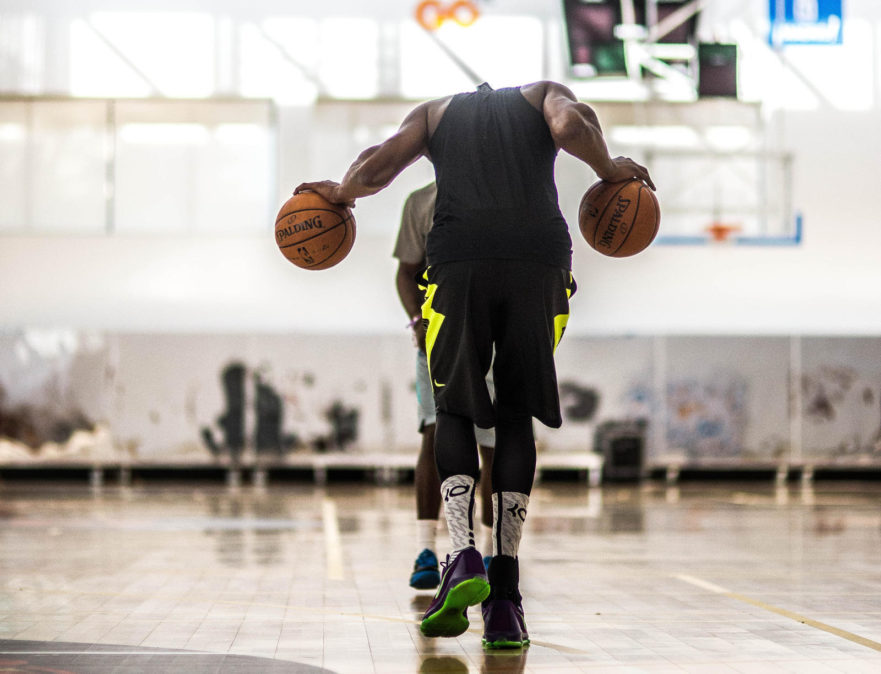Summer’s over, student-athletes are back in classes and high school practices will soon be underway. Many players spent a lot of hours working on their game, training and putting up shots. The next step is to transfer that hard work to the court and turn workouts into wins.
Push Others to Get Better
After working out throughout the summer, you have become a better player. But you are only one player and basketball teams demand rosters consisting of twelve athletes. Raise the level of those around you by showing teammates how to work out and encouraging them to join you in the weight room and n the court. Take what you’ve learned and share with the entire squad.
After losing to the Detroit in the 1990 playoffs, Michael Jordan began training with Tim Grover in order to get stronger. The training was paying off so Jordan invited Scottie Pippen and other Bulls to partake and the team won three championships in a row. After returning from retirement, Jordan, Pippen and Ron Harper would work out in the morning, bestowing the name “The Breakfast Club” upon these sessions. The three would train, eat breakfast together and went to their regular practice. With the team leaders modelling the way, Chicago claimed another three wings. Jordan new that developing himself was not enough to win — he needed to develop teammates too.
Rest and Recover
During the summer, it is easier to get extra sleep. One of the reasons that sixty-six percent of adolescents do not get enough sleep is because of the additional demands of school: homework, social life and other responsibilities. When athletes do not get enough rest, their bodies do not fully recover from a previous training session. Decision-making, performance and muscle soreness worsen. Even the risk of injury rises. Don’t let insufficient rest eat away at the gains that you made during the offseason.
Teenage athletes require about nine hours of rest. Put the phone away a couple of hours before bedtime because blue light increases restlessness. Drink enough throughout the day (bring a water bottle to class) and pack a snack (some protein and low GI carbohydrates) to consume after practice. Stretch after practice and at home to reduce muscle soreness. If you want to excel at school and basketball, you need to follow good recovery practices.
Play the Right Way
When athletes play pick up games afterschool or during open gyms, they are accountable to maintain a high level of intensity and quality. During the summer and the first few open gyms of the season, the coach may not be available to oversee every scrimmage. Pull together: it’s one thing to perform a skill on air during a drill but it’s another matter to do so against physical and aggressive defense. Although they scoreboard may not be in use, it’s not a reason not to defend the ball.
Firstly, I think that players need to play in competitive and challenging situations more. Secondly, those situations should mimic games. Playing with 1s and 2s or too much isolation will not translate to a team game. Rather than ceaselessly shooting or dribbling in workouts, coaches (and players) should create game-situations in order to apply their skills and make decisions. Lastly, try to win every game.
When Chuck Daly felt that the 1992 Dream Team was flat, he replaced practice with a full scrimmage. The players did not take it easy and participate in a glorified skills competition. They took it personally, went after every possession and ultimately regained the edge that they coach was seeking. Great players play hard even when nobody is watching — that’s how teammates make each other better.
Find the Weight Room
Although the best time for achieving individual gains is during the off-season, there is still enough time to load athletic factors during the Pre-Season General phase. The next six weeks provide an opportunity to update one’s goals and reach higher; the job isn’t done because the season is over. Some players who shoot or dribble very well in workouts find that they still have difficulties in games because they did not practice against tough defense.
Core stability and sport-specific movements are integral to basketball success. An athlete with a strong core can finish in traffic, post up near the basket and protect the ball. There are plenty of exercises in a high school weight room to help basketball strength: don’t limit yourself to curls and bench prices.
LeBron James is incredibly athletic but he understands that he must keep working. A typical day for him may involve some core exercises with resistance bands or heavy balls, free weights and sprint training before heading to the court. James can do the things that he does because he looks after his body. A student cannot train as much as a professional athlete but they can remember to train their entire body when they work out. It may be hard to access a good weight room in the community so take advantage of weight room hours at school.
Be Creative
After training for an extensive period of time, athletes can reach a plateau in terms of aerobic endurance, strength training or speed. Now that you are back at school, interact with coaches to assure that your movement skills and technique remain correct. It’s been a few months since you started the workout routine so it may also be time for a change in training to force the body to adapt.
During the 2014 offseason, Kevin Durant participated in a variety of training activities, for example running up sand dunes with Russell Westbrook to develop explosiveness. The novelty of an unusual training exercise serves as a challenge and forces the body to adapt. If you feel that you have reached a plateau in training, change something up (weights, reps, drills, exercises) to keep it interesting.
